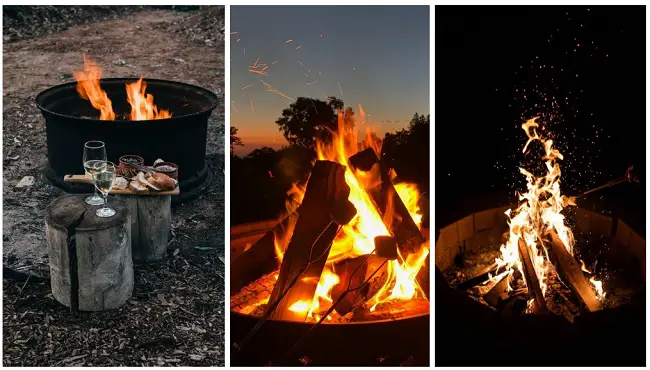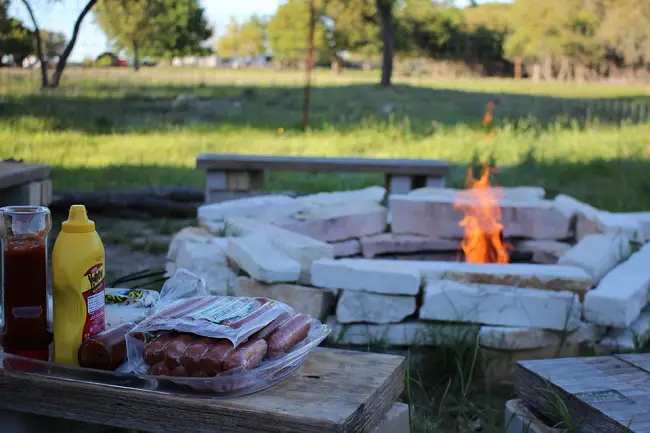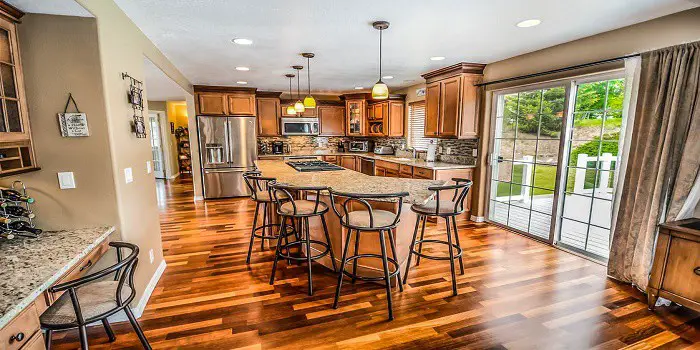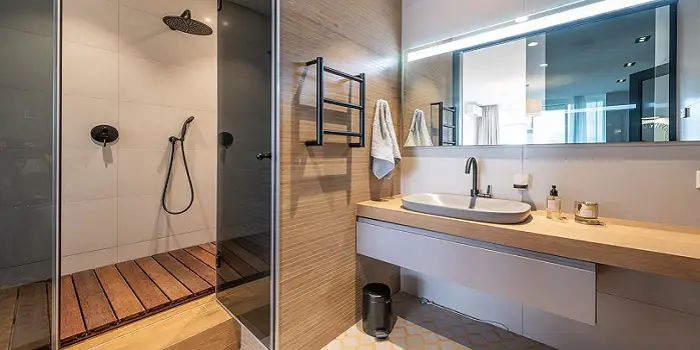
It may seem counterintuitive at first, but not all wood burns the same.
The last thing you want when building a fire pit or placing logs in the firepit is to watch the wood fizzle, create a lot of smoke, and fail to provide the warm, glowing flame that you were expecting.
The truth is that you need to choose the right type of wood for your fire that can burn well without causing any issues.
This means avoiding the types of wood that fail to generate the big, glowing flame that you want.
And choosing the type of wood that tends to burn hot, steady, and completely – leaving behind as little residue as possible.
Qualities of Good Firewood
There are several qualities to look for in firewood so that you get what you want from your fire pit.
No matter whether you are going camping or need the best wood for firepit use in your backyard – the two most important qualities to look for are density and dryness.
The dryer the wood, the better it will burn.
However, if there is too much moisture present, then it will not create the type of fire that you may desire.
Dense woods that are dry are the first things to look for in firewood. Dryness helps with another important aspect, aroma.
Wood that is moist will not only create an unpleasant odor if it contains mold or fungus, but it will also smell even worse.
So, be sure that the wood you use is dry (preferably kiln-dried) and dense for the best results.
Also, the amount of residue it leaves behind is highly important to check if you need the wood for indoor fireplaces as this helps keep your chimney cleaner over time.

Types of Firewood for Fire Pits
There are mainly two types of wood that are used for burning in fireplaces – hardwood and softwood.
As the names suggest, hardwood is a type of wood that is hard and takes longer to burn, while softwood is a type of wood that is soft and burns quickly.
So, it’s the hardwood type that will burn slower, cleaner, and with fewer fumes in fire pits.
Softwood tends not to burn as cleanly or produce the type of fire you want. Plus, some softwood has lots of resin or sap that may clog up your chimney in short order.
What follows are the best types of hardwood for your fire…
1- Almond
If you live in an area with almond groves, then this may be the best choice.
Almond tends to burn slowly over a long time. Plus, it leaves behind less ash compared to some other choices.
So, it is great for most fireplaces as well as fire pits.
The downside is that if you do not live in an area that has almond groves, then it may be difficult to obtain and quite expensive as well.
You will need to survey the choices in your area to ensure that almond is readily available.
2- Ash
Ash wood is among the most common choices for burning fire pits because you can burn the wood while it is still green.
Not only the wood burns the best, but it also produces a considerable amount of heat with very low smoke, so this is a good choice for colder climates where heat is highly desired.
Ash is easy to split, lightweight, and not that expensive which are all bonuses.
It does not last as long compared to oaks, but you can purchase more of it to feed the fire.
3- Avocado
This is arguably not the best choice since it tends to burn faster compared to other hardwoods.
Plus, it does leave behind more creosote, so it is not a good choice for fireplaces.
So, you may be wondering why avocado is on the list.
First, it is quite good at starting fires, so it makes for an excellent fire starting when you have other, tougher-to-burn hardwoods present.
And second, avocado is widely available, making it cheap and easy to obtain.
By adding a few logs of avocado to your firepit, you can get the wood to start burning faster.
4- Bigleaf Maple
Bigleaf Maple has considerable advantages starting with being relatively light in weight and less expensive compared to many other kinds of wood on this list.
While it may not burn quite as long as some oaks, it is easier to get the fire going and still burns considerably longer compared to softwoods.
If you are looking for a wood that works well at a social gathering where heat is not all that desired, then Bigleaf Maple is for you.
However, if you are looking for a heat-generating wood, then Bigleaf Maple does have some issues.
It simply does not generate as much heat compared to most oaks. So, if you are looking for a fire to keep you warm, there are much better choices available.
5- Black Oak
Sometimes called California Black Oak because of where it mostly grows in the US, this type of wood is one of the best you can obtain to burn in your fire pit.
Black Oak burns slowly and steadily for several hours, which is perfect for that outdoor fire pit and campfire cooking.
Be sure to obtain Black Oak that has been dried for at least a year, if not two years so that it is ready to burn.
In addition to the steady burning, it also leaves behind less ash and residue compared to most other woods, so cleanup is not as difficult.
6- Cedar
Cedar is a popular choice for campfires because it generates a considerable amount of heat.
It also has a pleasing aroma that is quite distinctive and pleasant, making for a wonderful evening around the fire.
Another advantage if you are storing cedar for the fire is that its natural properties keep out bugs and other pests.
The downside is that cedar does not produce a showy fire, meaning that you will not see nearly as much in terms of flames as you would from most oaks.
But if you are looking at staying warm, then cedar is a great choice.
7- Coast Live Oak
As the name implies, you can find this type of oak in the coastal areas of the US.
It’s tough and burns evenly without generating a lot of smoke in your firepit or campfire.
However, this type of oak is difficult to split, so you may need a log splitter or hire a tree trimmer to do the job.
This type of oak also burns hot, so it creates a fire that will keep you warm for most of the night.
Just be sure to fully put out the fire because its embers can smolder for several hours.
8- Hickory
Hickory is more associated with cooking compared to using it as a heat source, but it works quite well in fireplaces along with firepits.
This is because hickory is a dense wood that generates more heat than most other types.
Hickory burns quite well and holds little in the way of moisture, so it dries out faster compared to most other woods.
The downside is that the density of hickory makes it difficult to split, so for thicker pieces, you will need a machine or get professional help.
Otherwise, if your area of the country has plenty of hickory, then it is a great choice.
9- Pacific Madrone
This is a less common wood which makes it more difficult to find and often more expensive to purchase.
However, it does burn slow, hot, and leaves behind less ash and residue compared to most other woods. This makes it a perfect choice for fireplaces.
Another advantage is that it only takes about a year to dry out fully.
However, you should split the wood while it is still green. Otherwise, it becomes much harder to split the dryer it gets.
Because it leaves behind coals that are still warm in the morning, this is a great choice for those living in colder climates who use firewood to heat the home.
For fire pits, you will want to put them out completely at the end of the night.
10- Valley Oak
This is a hardwood native to California and is quite popular because it burns slowly while generating plenty of heat.
You will need to let it dry out for at least two years before using it as firewood, but it will be well worth it.
Valley Oak is more expensive than most other options, but it does burn quite long and leaves less of a mess behind.
11- Walnut
This is a common hardwood across the US and is a great option for those who want the fire to last for several hours without generating a lot of smoke.
Thanks to the long-burning qualities of walnut wood, once it does start burning you should not have to add much more to the fire to get going.
And that’s the main reason it’s great for fire pits and campfires outdoors, especially for those hosting winter parties and long gatherings in the evening.
12- White Oak
Sometimes called Oregon White Oak again because of where it mostly grows in the US, this type of wood is commonly found in Southern California as well.
It is arguably more common than Black Oak and also burns steadily.
However, it does produce more ash compared to Black Oak and most other oaks as well, so it may not be as desirable in fireplaces.
For campfires, this is less of an issue and White Oak does burn long and hot for several hours.
If you live near a source of apple or cherry, they make for excellent options as well.
Be sure to examine all the options in your area before choosing the type of firewood best for your needs.
What Type of Firewood Smells the Best?
I am sure you will not love to burn the wood in winters – if it stinks.
While the moisture content and dryness of the wood play a significant role, there are some popular kinds of wood that are known for their aromas.
These include cherry, oak, cedar, beech, pine, and hickory.
While cherry gives off a pleasing fruity aroma when burned, hickory is known for its savory classic scent, like a freshly baked ham.
Seasoned vs. Unseasoned Wood – What’s Better?
If you’re looking for some good quality wood for your firepits, then the best option would be to go for some seasoned wood.
Seasoned wood is basically wood that has been left out to dry for at least six months. This helps in getting rid of all the moisture from the wood, and as a result, it burns much better. Not to mention, it also lasts a lot longer.
Unseasoned wood, on the other hand, contains a high percentage of water. This makes it hard to light and also doesn’t burn as well.

What Type of Wood You Should Avoid Burning?
Not all wood is made alike.
There are some types that are perfect for the stove, fireplace, outdoor fire pit, or campfire.
While there are other types that you should never use for burning at all.
While many purchase a log splitter with the intent of chopping up wood to use in such circumstances, it is best to stick with the maples and oaks that provide the best burning.
What follows are the worst types of wood that you should not use in your fireplace, stove, fire pit, or anywhere else.
This is wood that is simply not suitable to burn for several different reasons.
1- Conifers
This type of wood includes spruce, fir, and pine.
They are cone-bearing trees that are quite common in the forest.
And which such wood can be burned, they are not recommended for indoor fires.
That’s because they contain a considerable amount of resin called pitch that does not burn but instead creates creosote.
The creosote will rise and line the chimney, creating a dangerous situation as it is flammable.
Conifers are more suited to outdoor burning, but only when used in small quantities when combined with larger amounts of oaks, maples, and other suitable woods.
Because conifers tend to burn quickly, they help get a fire going.
Plus, the small amount of creosote generated will matter little when used in a large outdoor firepit or campfire.
Be aware that conifers tend to spark and crackle, making them dangerous if they touch flammable material.
So, only use them outdoors and in small amounts to get the fire started.
2- Diseased or Pest-Damaged
You may wonder why this type of wood is on the list since many professionals recommend using fire to get rid of them.
The answer is not so much in the burning but rather in the transportation of the wood to the location where it is to be burned.
If you are chopping down a diseased tree and burning it nearby, that is fine.
But if you are storing the diseased wood and transporting it by vehicle, that is another issue.
If the wood contains the termite or emerald ash borer, you risk spreading it to other trees and causing further damage.
In addition, if the tree suffers from oak wilt disease, then the fungus inside will be released and spread around to affect other oaks in the area.
It is far better to chop up and burn the diseased or pest-damaged wood in a location that is nearby and will not affect other trees.
3- Green
This is wood from trees that have been recently felled.
Greenwood still contains plenty of moisture, which makes it more difficult to burn.
When heated, the water inside the trees will turn to steam, which tends to dampen the flames and reduce the heat output.
Drying or seasoning the wood for several months up to two years, depending on the type, is best.
Leaving the wood outside allows the moisture inside to seep out. This leaves behind dry wood, which catches fire easier and burns far more efficiently.
But more importantly, green or wet wood is more likely to produce creosote which is bad for your chimney.
Creosote is not only sticky and difficult to clean it also represents a fire hazard when it becomes caked to a surface.
So, let the wood dry out as completely as possible before using it in a fire.
4- Ocean Driftwood
Driftwood that comes from freshwater sources tends to be okay to use in a fire, assuming it has fully dried out and is free of mold, mildew, or fungus.
However, ocean driftwood is dangerous to burn because it has absorbed chlorine which is in the form of chloride.
When burned, it combines with other substances in the wood to create dioxin, which is a cancer-causing agent.
Burning ocean driftwood on an open beach is bad enough, but it is worse when in an enclosed area as it concentrates the cancer-causing properties.
This is why most oceanside communities ban the burning of ocean driftwood.
5- Poison Ivy
While poison ivy, along with poison sumac and oak – are not woods, many people, when clearing the land, will toss the stems into a fire to get rid of them.
They often find their way into firepits and campfires just for that purpose. That is something you should never do.
Poison ivy, oak, and sumac contain urushiol, which is a substance that causes a rash on the skin when touched.
When inhaled from the smoke, it can get inside your lungs and cause an allergic reaction. You should seek medical care immediately.
However, you can avoid all this by not tossing any plant or substance in the wood that you do not recognize.
6- Treated Wood
Any wood that has been treated with chemicals should not be tossed into a fire.
This is because the chemicals used will be released from the wood and find their way into your lungs.
Such woods include coated, sealed, painted, and pressure treated.
Also, any wood containing glue, such as particleboard or plywood, is not suitable for burning.
Many types of glue that are used contain formaldehyde which, when released into the air, may cause cancer.
Arguably the worst type is wood that has been treated with chromated copper arsenic or CCA. This was often used to treat wood and keep it from rotting.
CCA has not been in many years, but if you are trying to get rid of older wood, CCA may still be present.
7- Wax Logs
Artificial wax logs are often used in outdoor fires, but they are not suited for indoor use.
This is a manufactured wood that is made from sawdust held together by wax.
When lighted, the wax burns away and helps ignite the sawdust.
The issue is that the wax creates temperatures far higher than fireplace inserts or wood stoves can typically handle, which may set them on fire as well.
Any artificial log you use indoors should only be made of 100% sawdust with no wax or any other substance present.
Use the wax logs for your outdoor fires where the higher temperature generated matters far less.

Eco-friendly Wood Alternatives for Fire Pits and Fireplaces
The average campfire burns at a temperature of around 1,000 degrees Fahrenheit.
However, depending on the size and intensity of the fire, it can burn at temperatures as high as 2,000 degrees Fahrenheit.
The main problem with burning wood in camping and road trip fire pits is that it can release harmful chemicals into the air. These chemicals can include carbon monoxide, soot, and ash.
Another problem with burning wood is that it can produce a lot of smoke. This smoke can be a nuisance to your neighbors and can also be harmful to your health.
Finally, burning wood in bonfires can also lead to the formation of creosote. This is a sticky, flammable substance that can build up on the inside of your chimney and endanger your home.
If you’re looking for a more environmentally friendly option for your wood-burning fire pit or fireplace, there are plenty of wood alternatives available.
From recycled options to those made from sustainable materials, there are plenty of eco-friendly options to choose from.
a) Recycled Coffee Grounds:
One option is to use recycled coffee grounds as fuel for your fire. Coffee grounds are a great source of energy and will help to keep your fire burning for longer.
Plus, they’re a great way to recycle coffee grounds that would otherwise end up in landfills.
b) Pellets:
Another option is to use wood pellets and biomass bricks as fuel for your fire. Pellets are made from compressed sawdust and are a renewable resource.
They’re also very efficient, so you’ll get more heat from them than you would from wood.
c) Biochar:
Biochar is a type of charcoal that’s made from sustainable materials like bamboo.
It’s a great way to fuel your fire while also helping to improve the soil in your garden.
d) Soy and Switchgrass Logs:
You can also find soy and switchgrass logs that can be used as fuel for your fire.
These are made from sustainable materials and are a great way to add heat to your fire without using wood.
e) Coconut Shells:
Coconut shells make great fuel for your fire.
They’re renewable, they’re environmentally friendly, and they’ll help to keep your fire burning for longer.
Keep in mind that you should never use plastic or materials that contain plastic-like elements as fuel for your fire.
These materials can release harmful chemicals into the air when they’re burned.
When choosing an eco-friendly wood alternative for your fire pit or fireplace, make sure to choose a product that’s made from sustainable materials.
This will help to protect the environment and ensure that your fire pit or fireplace is as eco-friendly as possible.
Final Thoughts
Knowing what wood varieties to burn in the fire pit (and what you should not), can help a lot in preparing your house for winter evenings.
Keep in mind that not all kinds of wood burn very well, and not all of them would emit a pleasing aroma.
So, choose the firewood wisely based on your personal preferences and goals.
If it’s simply for a long-lasting warm firepit, hardwoods such as oak and ash can be your option.
But if you need the most fragrant wood for keeping your firepit smelling good hickory is a great addition.
Share the post "What is the Best Wood to Burn (For Fire Pit & Campfire)"

Hi, I am Mark Garner a professional carpenter, woodworker, and DIY painter. I live in the small city of Peoria, Arizona as a semi-retired woodworker. I have started this blog with a simple motive to help you with my wood experience in this sector. If you like to know more about what I love doing and how it all got started, you can check more about me here.




